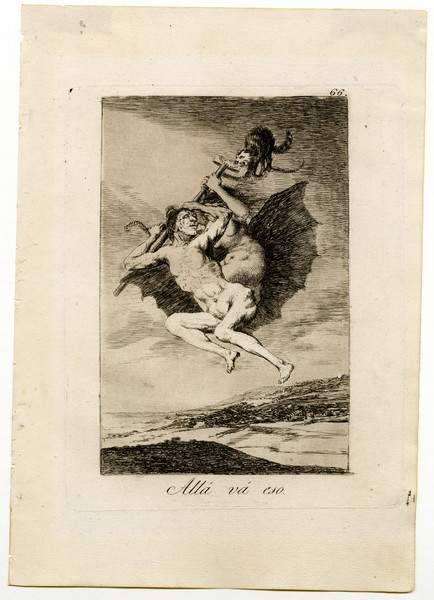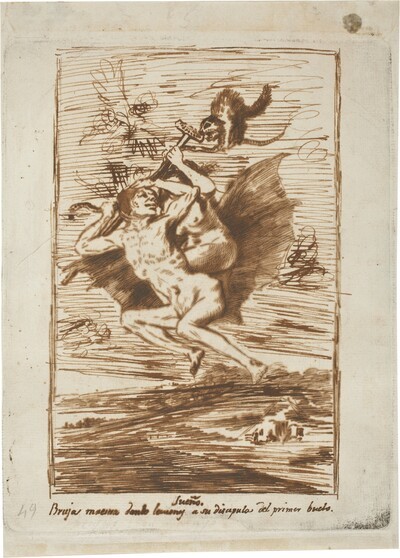- Cronología
- Ca. 1797 - 1799
- Dimensiones
- 210 x 167 mm
- Técnica y soporte
- Aguafuerte, aguatinta y punta seca
- Reconocimiento de la autoría de Goya
- Undisputed work
- Ficha: realización/revisión
- 09 Jan 2011 / 29 May 2024
- Inventario
- 225
Allá vá eso (at the bottom)
66. (in the upper right-hand corner)
See Francisco de Goya y Lucientes, Painter.
There is a proof of a pre-print state with aquatint and drypoint preserved in the National Library in Madrid.
A preparatory drawing of this engraving is in the Prado Museum.
As part of the series of The Caprices, Goya continues to depict scenes of witches flying. In this case, the protagonist is an old sorceress who teaches a younger woman to fly by means of bat wings. In the print we can see the two naked bodies of the women, first of all that of the older one who is tutoring the younger one behind her and whom she looks at by turning her head. Both are holding on with their arms above their heads to what looks like a crutch, on the end of which we see a cat with bristling hair. The teacher is also holding a snake in one of her hands. In the background of the engraving, a village stretching out on a plain can be seen.
The white areas on the face of the cat, on the stomach and on the legs of the old witch barely contrast with the aquatint, which has been worn away in the course of the various prints.
In the manuscript in the Prado Museum there is a reference to the Diablo Cojuelo (Little Devil). This was a character from popular 17th-century Castilian literature. Luis Vélez de Guevara (Écija, Seville, 1579-Madrid, 1644) wrote a work entitled The Little Devil (1641) in which he narrates the adventures of this character in Madrid together with the nobleman Don Cleofás Leandro Pérez Zambullo. Furthermore, Cojuelo is regularly referred to in a number of Castilian proverbs and sayings, and was even considered to be a good messenger of love, to the extent that he was invoked in several incantations.
The manuscript in the National Library provides us with a somewhat more precise interpretation than in the other texts that have come down to us. It reads as follows: "The cunning old women are the ones who lose the young women; they drive them away, and teach them to be snakes and martens of the pockets".
The witches' forceful anatomies, their muscular and almost masculine forms, are reminiscent of some of the Michelangelo images in the Sistine Chapel. It is possible that, albeit as a distant echo, this is one of the visual sources to which Goya turned when creating images such as the one we are dealing with here.
The aquatint of the plate is considerably worn. There is a scratch in the sky, under the figures on the left side ( National Chalcography, no. 237).
-
De grafiek van GoyaRijksmuseum RijksprentenkabinetAmsterdam1970from November 13th 1970 to January 17th 1971cat. 44
-
Goya. Das Zeitalter der Revolucionen. Kunst um 1800 (1980 – 1981)Hamburger KunsthalleHamburg1980cat. 8
-
Goya. La década de Los CaprichosMadrid1992organized by Real Academia de Bellas Artes de San Fernando sponsored by Fundación Central Hispano, Madrid, consultant editor Nigel Glendinnig. From October 26th 1992 to January 10th 1993cat. 32
-
Francisco de GoyaMuseo d'Arte ModernaLugano1996exhibition celebrated from September 22nd to November 17th.cat. 66, p.93
-
Ydioma universal: Goya en la Biblioteca NacionalBiblioteca NacionalMadrid1996from September 19th to December 15th 1996cat. 125
-
Francisco Goya. Sein leben im spiegel der graphik. Fuendetodos 1746-1828 Bordeaux. 1746-1996Galerie KornfeldBern1996from November 21st 1996 to January 1997cat. 72
-
Goya e la tradizione italianaFondazione Magnani RoccaMamiano di Traversetolo (Parma)2006consultant editors Fred Licht and Simona Tosini Pizzetti. From September 9th to December 3th 2006cat. 66, p.162
-
Goya. Opera graficaPinacoteca del Castello di San GiorgioLegnano2006exhibition celebrated from December 16th 2006 to April 1st 2007p.41
-
Goya e ItaliaMuseo de ZaragozaZaragoza2008organized by the Fundación Goya en Aragóna, consultant editor Joan Sureda Pons. From June 1st to September 15th 2008cat. 342
-
Goya et la modernitéPinacothèque de ParisParís2013from October 11st 2013 to March 16th 2014cat. 169
-
Goya: Order and disorderMuseum of Fine ArtsBoston2014cat. 215
-
2022
-
Goya engravings and lithographs, vol. I y II.OxfordBruno Cassirer1964p.143, cat. 101
-
Vie et ouvre de Francisco de GoyaParísOffice du livre1970p.183, cat. 583
-
Goya, la década de los caprichos: dibujos y aguafuertesMadridReal Academia de Bellas Artes de San Fernando1992pp.52-53, cat. 32
-
El libro de los caprichos: dos siglos de interpretaciones (1799-1999). Catálogo de los dibujos, pruebas de estado, láminas de cobre y estampas de la primera ediciónMadridMuseo Nacional del Prado1999pp.334-337
-
ParísPinacoteca de París2013p. 234
-
Goya: Order & DisorderBostonMuseum of Fine Arts Boston Publications2014pp. 310-314
-
Goya. In the Norton Simon MuseumPasadenaNorton Simon Museum2016pp. 42-75
-
Museo de Bellas Artes de Badajoz y Diputación de Badajoz2022p. 48

